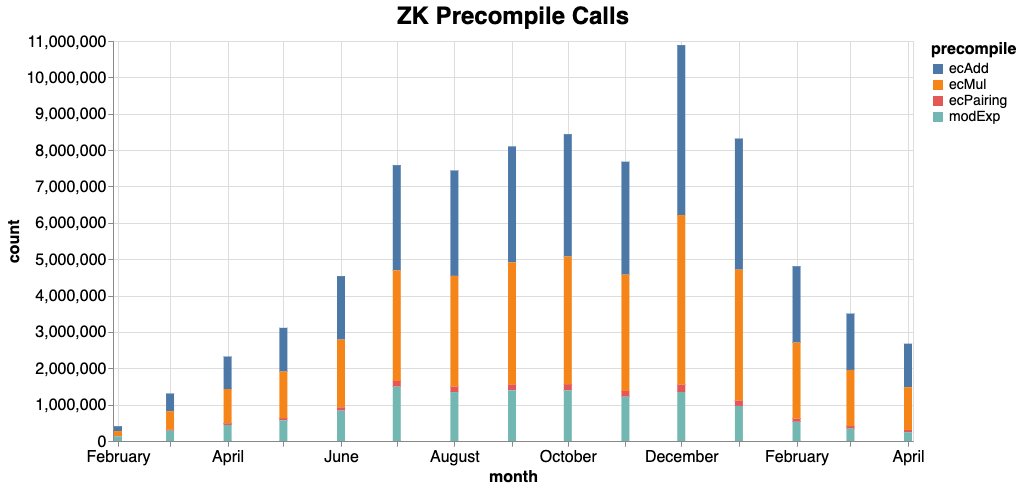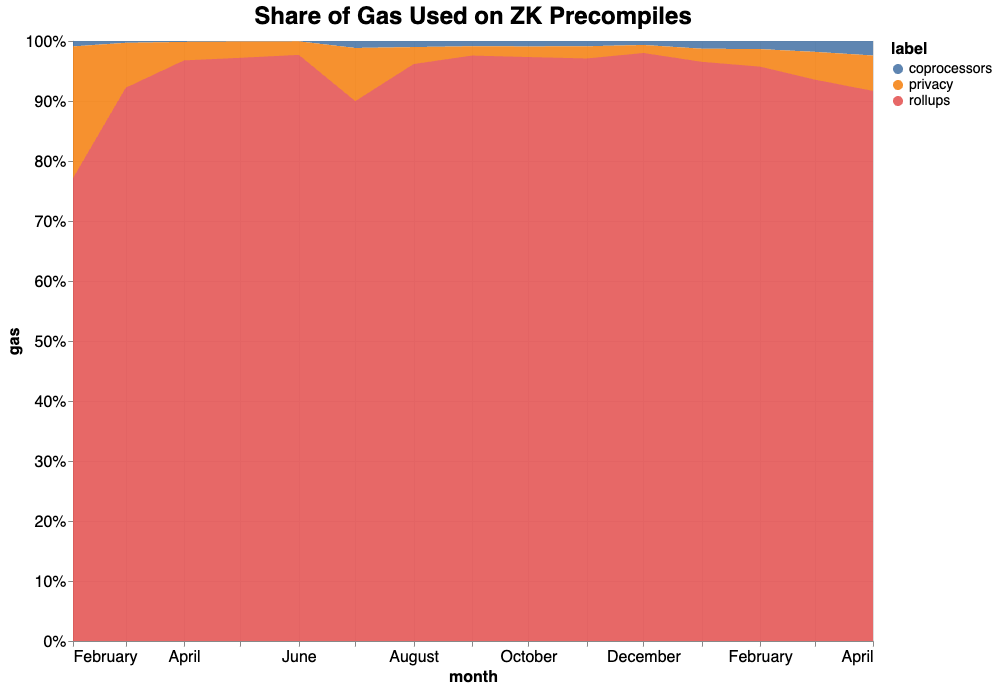Introducing the ZK Market Map! We’ve charted 250+ crypto projects advancing zero knowledge (ZK) tech.
This detailed map is an extension of our Crypto Market Map meant to showcase the differences between projects within ZK subsectors.
Why did we make this and why does ZK matter?
This detailed map is an extension of our Crypto Market Map meant to showcase the differences between projects within ZK subsectors.
Why did we make this and why does ZK matter?

ZK and verifiable compute are boosting the scalability of blockchains, increasing trustlessness on the internet, and unlocking new use cases for blockchains.
Years of ZK research is coming to life today in 3 main ways:
1. Scability
2. Trustlessness
3. New Use Cases
Years of ZK research is coming to life today in 3 main ways:
1. Scability
2. Trustlessness
3. New Use Cases
Scalability
ZK rollups are utilizing validity proofs to increase throughput and reduce time to finality while maintaining decentralization. Provable execution allows for complex onchain programs to run more efficiently offchain.
ZK rollups are utilizing validity proofs to increase throughput and reduce time to finality while maintaining decentralization. Provable execution allows for complex onchain programs to run more efficiently offchain.
Trustlessness
Verifiable compute is removing the need for trusted intermediaries. Imagine a world where bridges aren't secured by multisigs but by hard cryptographic proofs. We’re nearly there thanks to an explosion of zkVMs and the build out of the proof supply chain.
Verifiable compute is removing the need for trusted intermediaries. Imagine a world where bridges aren't secured by multisigs but by hard cryptographic proofs. We’re nearly there thanks to an explosion of zkVMs and the build out of the proof supply chain.
New Use Cases
Innovations like TLSNotary provide powerful tools for startups to bridge web2 data over to web3.
Coprocessors enable DeFi projects to manage their protocol parameters algorithmically and trustlessly.
And there's more being built in zkML, zkFHE, compliance, etc.
Innovations like TLSNotary provide powerful tools for startups to bridge web2 data over to web3.
Coprocessors enable DeFi projects to manage their protocol parameters algorithmically and trustlessly.
And there's more being built in zkML, zkFHE, compliance, etc.
ZK can be applied to all of crypto. We broke down projects that utilize ZK into 5 layers:
- Core Infrastructure
- Interoperability & Middleware
- Developer Tools & Services
- Protocols
- Applications
These categories aren't rigid and a project could fit into many categories.
- Core Infrastructure
- Interoperability & Middleware
- Developer Tools & Services
- Protocols
- Applications
These categories aren't rigid and a project could fit into many categories.
Core Infrastructure
This foundational layer includes projects focused on blockchains, scaling layers, hardware, and virtual machines. These components are essential for building scalable and efficient ZK solutions.
This foundational layer includes projects focused on blockchains, scaling layers, hardware, and virtual machines. These components are essential for building scalable and efficient ZK solutions.
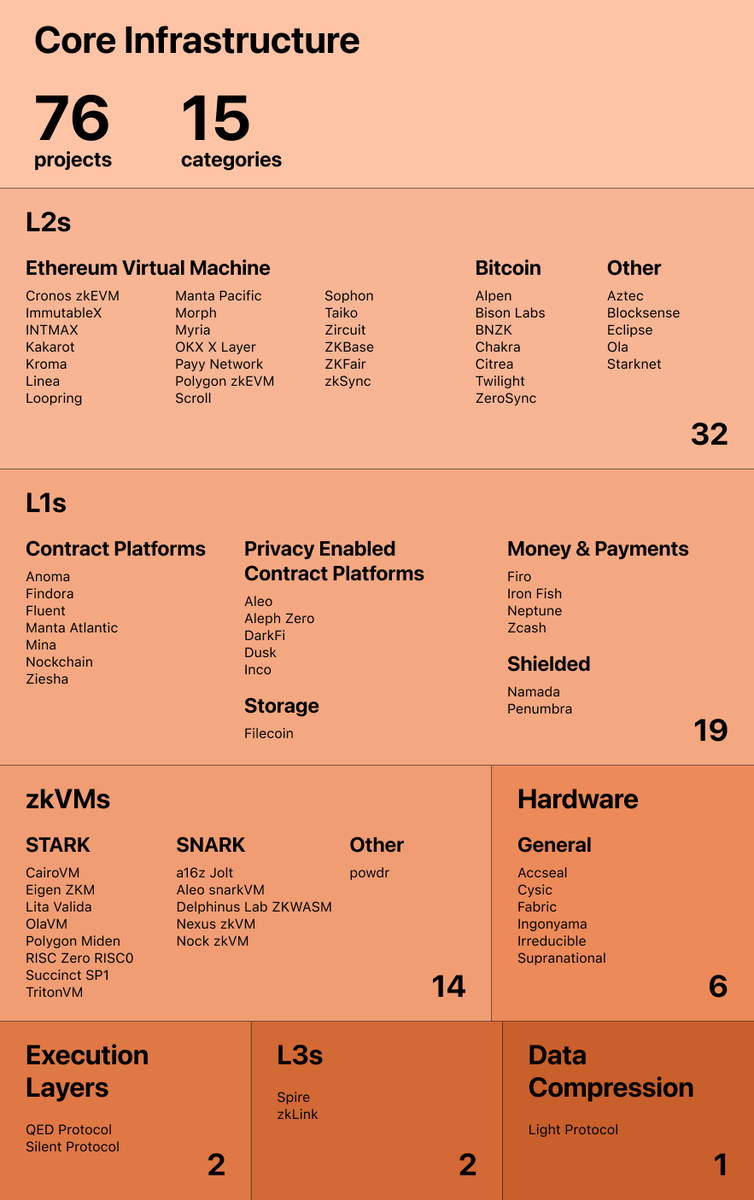
Interoperability & Middleware
Projects in this layer utilize ZK to provide cross-chain communication, offchain compute, and core services in ways that are more efficient and trustless.
Projects in this layer utilize ZK to provide cross-chain communication, offchain compute, and core services in ways that are more efficient and trustless.

Developer Tools & Services
This layer includes tools, frameworks, providers, and services designed to help developers and users. Some examples are tools for building on ZK-powered infrastructure, SDKs for utilizing hidden state, and services that leverage ZK to preserve privacy.
This layer includes tools, frameworks, providers, and services designed to help developers and users. Some examples are tools for building on ZK-powered infrastructure, SDKs for utilizing hidden state, and services that leverage ZK to preserve privacy.
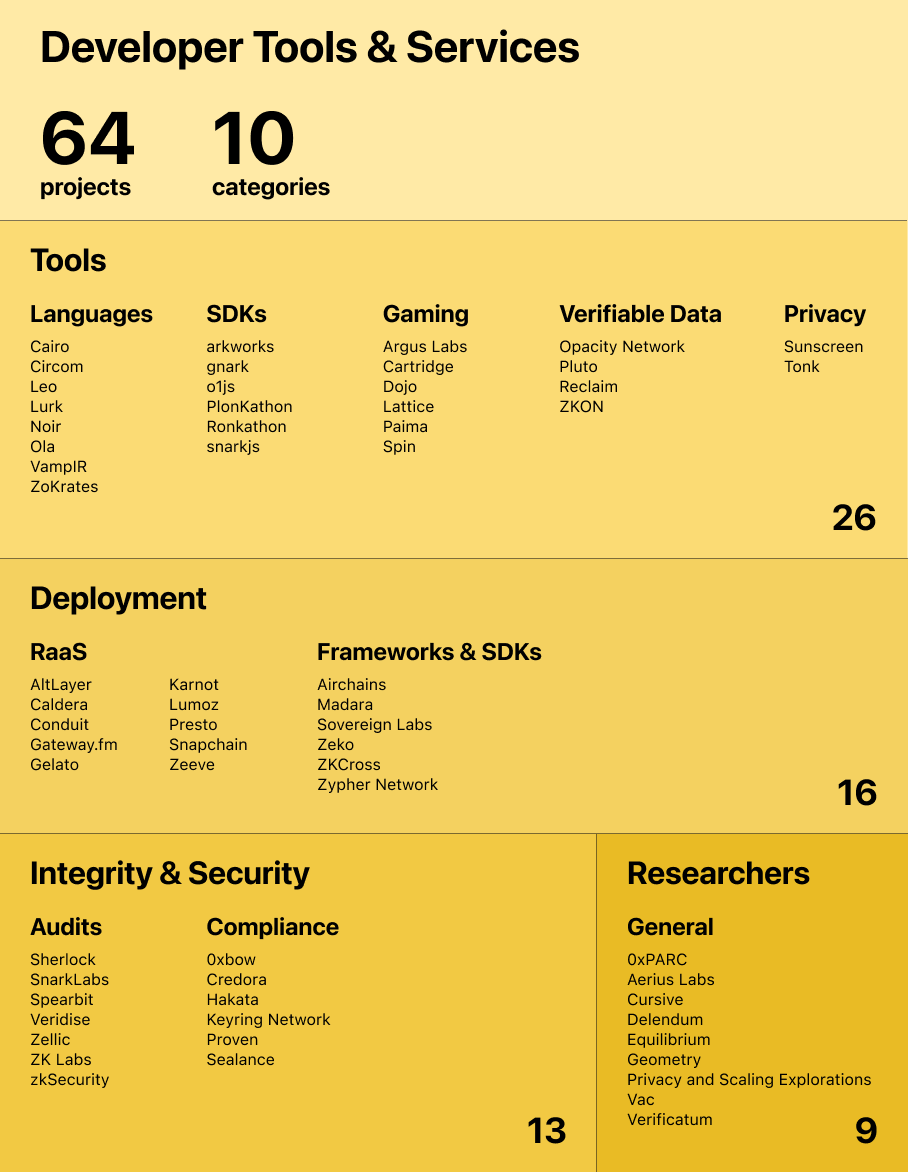
Protocols
Protocols are typically open source projects that allow anyone to build front end applications on top of or utilize their data and logic. This layer spans various use cases, including DeFi, identity management, and privacy solutions.
Protocols are typically open source projects that allow anyone to build front end applications on top of or utilize their data and logic. This layer spans various use cases, including DeFi, identity management, and privacy solutions.
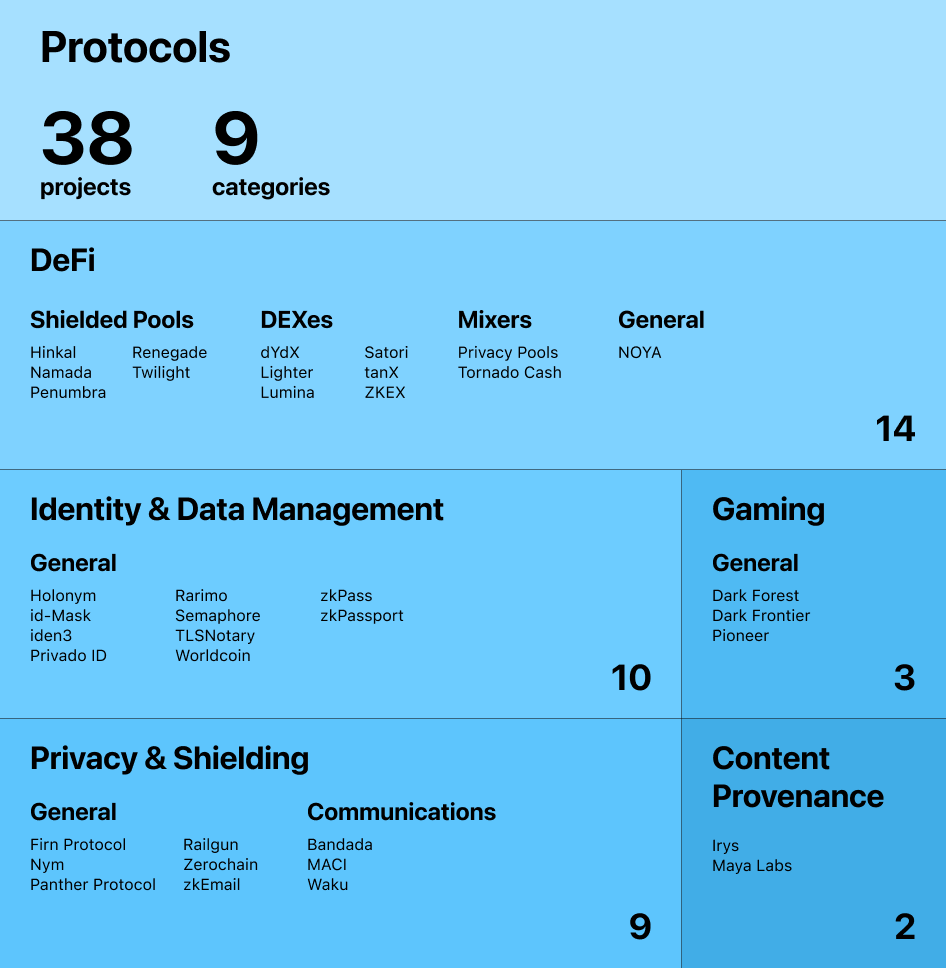
Applications
Applications have well maintained front ends, primarily serve end consumers, and/or have some centralized data or execution. These projects leverage underlying protocols and infra to deliver user-facing solutions in areas like finance, gaming, and social platforms.
Applications have well maintained front ends, primarily serve end consumers, and/or have some centralized data or execution. These projects leverage underlying protocols and infra to deliver user-facing solutions in areas like finance, gaming, and social platforms.
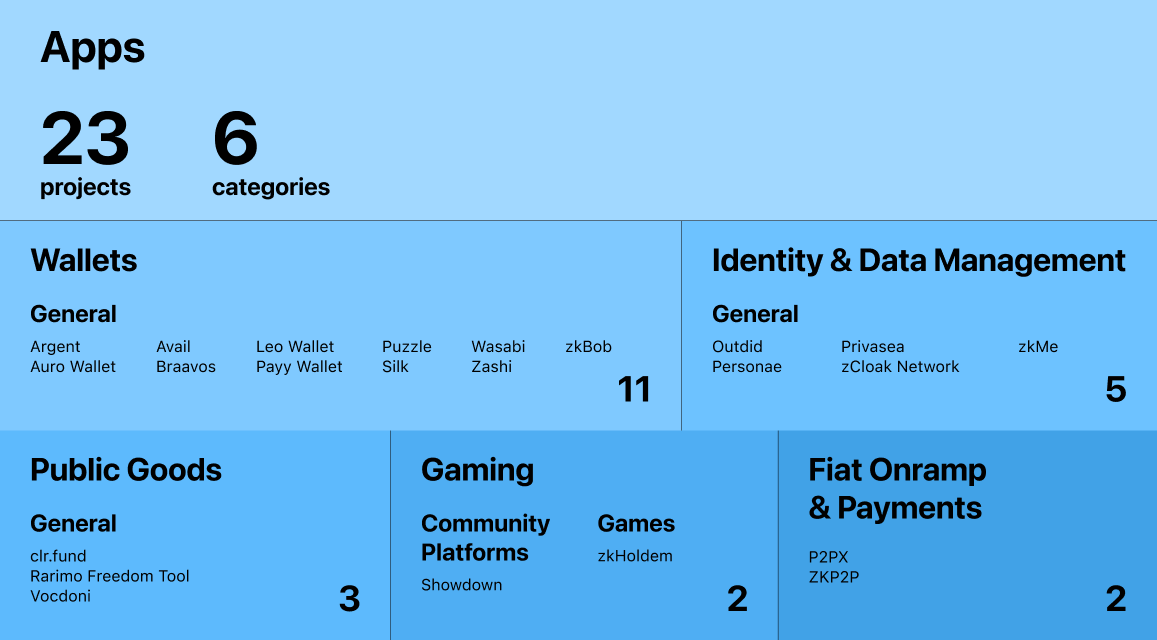
Today, most ZK projects are infra projects. ~80% of the projects in the map are Developer Tools & Services, Interoperability & Middleware, and Core Infrastructure.
From a dollars perspective, 23 of the top 25 ZK fundraises since 2021 were Core Infra or Interop & Middleware.
From a dollars perspective, 23 of the top 25 ZK fundraises since 2021 were Core Infra or Interop & Middleware.

Just as blockchains from 2015-2020 spawned a competitive market for decentralized consensus, zkVMs and the proof supply chain are creating a competitive market for proof generation. This will drive innovation in ZK apps by making proving infrastructure accessible for developers.
Applications will soon proliferate and the 80% of projects being infra will flip to < 50%.
If you are building or exploring in ZK we'd love to hear from you. Send me a DM!
If you are building or exploring in ZK we'd love to hear from you. Send me a DM!
To wrap up, I want to thank the team for their work on this.
Research: @mariashen
Design: @ElenaM1096151 @mishafrolov
Eng: @lucasg_dev @0x9e0ff
Research: @mariashen
Design: @ElenaM1096151 @mishafrolov
Eng: @lucasg_dev @0x9e0ff
And another huge thank you to @0xkrane and @HeslinKim for their valuable feedback on the map.
You can view the original Crypto Market Map that we released last month here:
https://x.com/MariaShen/status/1811115384059359378
The ZK Market Map will evolve over time. If you notice any omissions, misclassifications, have suggestions, or just think it sucks, please let us know.
You can leave feedback here:
airtable.com/appQG8Z7XNVDQz…
You can leave feedback here:
airtable.com/appQG8Z7XNVDQz…
• • •
Missing some Tweet in this thread? You can try to
force a refresh



